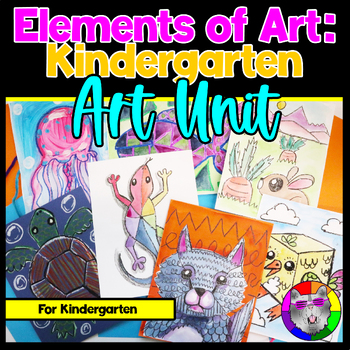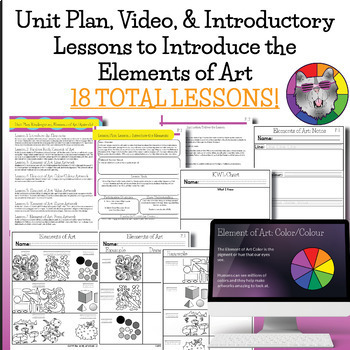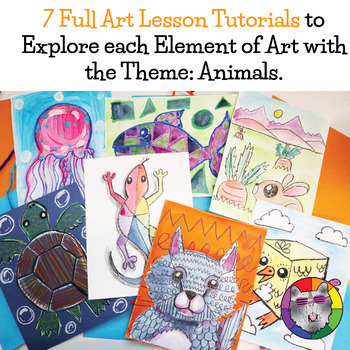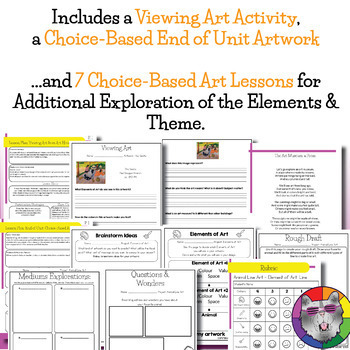Kindergarten Art Lessons, Elements of Art Unit & Animal Themed Art Projects
- Zip
What educators are saying
Also included in
- This is the BEST K-5 Art Curriculum, Art Project and Resource Bundle and it is the PERFECT way to Introduce the Elements of Art, Art Making Processes, and a Variety of Themes to your Students with Art Projects for each element, videos, themes and art activities. Not only are there FULL units for GraPrice $221.54Original Price $276.92Save $55.38
Description
Plan and Teach Art with a NO Prep, Fun, Ready-Made Kindergarten, Elements of Art, COMPLETE Art Lesson Unit! This Elements of Art Unit introduces and teaches the Elements of Art with an introduction video and lessons, includes Step-by-Step Art Tutorials for each Element, AND includes Choice-Based Art Lessons to allow for experimentation and play-based, student-choice learning. This Kindergarten Art Unit teaches the Elements of Art through the theme of Animals for high engagement and increased student interest.
Do you want your Kindergarten students to make art, learn about the Elements of Art, and develop their drawing and fine motor skills? Are you short on time or are you looking to access a fully planned art unit that teaches the Elements of Art, includes full step-by-step art tutorials AND Choice-Based Art Lessons? Do you need a full video that you can play in your classroom to introduce the Elements of Art at an age-appropriate level? Are you looking for highly engaging, high interest art lessons to help you plan and be ready for teaching art like a pro no matter your art skills in minutes? This Art Resource is Ready for easy black-line printing!
♡A perfect solution for a busy teacher with a whole year to prep!♡
☛ Because this is a complete unit, it is also a wonderful program for Homeschool Families as a Homeschool Curriculum to follow as a grade specific guide.
☛SUBSCRIBE to my YouTube Channel and find FREE Resources
✂GET MORE Art Resources at MsArtastic.com
FOLLOW ME:
♡Instagram☛Facebook✂Pinterest✎Twitter
_________________________________
THIS KINDERGARTEN ELEMENTS OF ART RESOURCE INCLUDES:
*Fully-Planned, Non-Editable PDFs in a Folder
1) UNIT PLAN
-a unit plan to share the scope and sequence for this unit
2) 2 INTRODUCTION TO THE ELEMENTS OF ART LESSONS
-1 Video in the folder that introduces the Elements of Art, Why Artists use them, and the theme of this unit: Animals
-2 Introductory Lessons with full lesson plans and worksheets to introduce the Elements of Art and practice drawing each element of art.
3) 7 Fully-Planned Art Lesson Tutorial, 1 Artwork for Each Element of Art and in the theme: Animals
Each includes:
-Complete Lesson Plan with Lesson Hook, Participation Strategies, Steps for Instruction, and how to Conclude the Lesson
-Step-by-Step Tutorial for making the Artwork
-Includes Artwork Examples & Display Sign
-Rubric, Assessment, & Reflection
THE 7 FULL ART PROJECT TUTORIALS:
-Element of Art Line Artwork: Students will create an artwork of a wolf that explores the Element of Art Line through the use of line to create pattern and design on both the subject, the wolf, and the background. This artwork will also explore mixed media processes and wax resist painting.
-Element of Art Color/Colour Artwork: Students will explore the Element of Art Color through creating a Rainbow Gecko as a color wheel to explore colors artists use to create art.
-Element of Art Value Artwork: In this art lesson students will be creating Jellyfish paintings with tempera paint to explore the Element of Art Value. Students will follow a tutorial to draw and paint the jellyfish, creating a variety of values with the thick and thin areas of the paint.
-Element of Art Shape Artwork: In this Art Lesson, students will first draw an organic shape- a fish. Then, they will create a mosaic in the fish’s body using geometric shapes. Students will also draw geometric shapes in the background to create an artwork that allows a lot of practice drawing shapes , but also uses them for design.
-Element of Art Form Artwork: In this art lesson students will be creating cube shaped birds to explore the Element of Art Form. Students will follow a tutorial to draw the bird but can add their own artist flavor to the design to add individuality to their artwork and make it their own.
-Element of Art Space Artwork: In this art lesson students will be creating a landscape with carrots and a bunny to explore the Element of Art Space. Students will follow a tutorial to draw the landscape, using size and position in relation to the horizon line to create the illusion of depth on the two-dimensional surface. This is a wonderful lesson to explore designing a natural environment.
-Element of Art Texture Artwork: In this art lesson students will be creating Texture Turtles to explore the Element of Art Texture. Students will follow a tutorial to draw the turtle and will use line to help create texture on the turtle.
4) 7 Choice-Based Art Projects to Explore the Elements of Art & the Theme: Animals.
There are 7 Choice-Based Art Lessons for each Element of Art. They have no example to allow students to develop their own choice, student-led concepts but allow them to play with mediums, techniques, and concepts to practice each of the Elements of Art. You may use or integrate them into the learning any time you would like either before a full art tutorial lesson to practice & play before they explore an element in depth OR use after to reinforce concepts and techniques learned and to allow for student-led investigations of ideas and skills.
Choice-based learning leads to student empowerment, higher engagement as they investigate their own ideas, and inspires students to want to learn new things. Choice in the classroom is linked to higher student effort and task completion which leads to more learning in the classroom. It also gives the learner a greater sense of control over their own ideas and interests and the ability to integrate their background and imagination. Choice-based learning allows students to grow at their own pace and investigate their ideas in addition to investigating concepts learned in class. Adding this allows students multiple ways to reach a learning objective.
Each includes:
-Complete Lesson Plan with Lesson Hook, Participation Strategies, Steps for Instruction, and how to Conclude the Lesson
-Planning, Rough Draft, Artwork pages
-Rubric, Reflection pages
-*no examples included as this is Choice-based learning and is teacher-guided and student-led learning for exploration & experimentation and creative freedom.
5) Viewing Art Lesson Activity
Students will view an artwork from art history and will use their critical thinking to identify Elements of Art in the artwork and consider the importance of viewing art and the importance of art museums and how they are different from other buildings.
6) Choice-Based, End of Unit Art Project
Teacher will guide students through an End of Unit, choice-based artwork where students create an artwork that focuses on using two different Elements of Art and their theme in the design. As a class, students will create student-led criteria for the artwork, then each student will develop their own artwork supported with the resources and their teacher.
_________________________________
NATIONAL ART STANDARDS THIS UNIT COVERS:
Kindergarten:
VA:Cr1.1.Ka - Engage in exploration and imaginative play with materials
VA:Cr2.1.Ka - Through experimentation, build skills in various media and approaches to artmaking.
VA:Cr2.3.Ka - Create art that represents natural and constructed environments.
VA:Cr3.1.Ka - Explain the process of making art while creating.
VA:Pr4.1.K - Select art objects for personal portfolio and display, explaining why they were chosen.
VA:Pr5.1.Ka - Explain the purpose of a portfolio or collection.
VA:Pr6.1.Ka - Explain what an art museum is and distinguish how an art museum is different from other buildings.
VA:Re.7.1.Ka - Describe what an image represents
VA:Re8.1.Ka - Interpret art by identifying subject matter and describing relevant details.
VA:Re9.1.Ka - Explain reasons for selecting a preferred artwork
_________________________________
HOW TO PREP:
-Review the Unit Plan to find the sequence for teaching the art lessons
-Start with the Introductory Art Lessons & Video
-Print your master copy and organize into a binder. Use the binder cover as the cover for the binder or the inside title page for a section in a binder.
-Photocopy student pages as necessary
-Use the binder as a quick reference for easy planning with simple or flexible art mediums
-Pick an Art Lesson & Teach
HOW TO USE:
-Follow each lesson plan as it specifically will tell you how to teach the lesson from the lesson hook, participation strategies, steps to teach, and conclusion.
-Print it off and keep it organized in a binder or a tub to make it easy to grab and teach!
-Photocopy student pages in advance & keep organized in folders for advanced, organized prepping.
*****************************************************************************
Customer Tips:
Be the first to know about my new discounts, freebies and product launches:
• Look for the green star next to my store logo and click it to become a follower. Voila! You will now receive email updates about this store. ☺
*****************************************************************************
Images and Lessons are Copyright Products to Ms Artastic & Artastic Collective
YOU MAY:
-Enjoy using this resource year-after-year with the students in your classroom
-Use this in creative ways! Explore and have as much fun with it as you would like
-Buy additional licensing for sharing with other teachers.
YOU MAY NOT:
-Use this on OutSchool
-Use this for your own commercial business (it should be used as a teaching resource for your classroom).
-Share the video on any PUBLIC website or blog such as YouTube/Vimeo or a classroom blog/website where anyone in the public can view it. This should be used for YOUR CLASSROOM only. If no one else can see it, use it over and over.
-Put this your Blog or any other publicly accessed website where anyone can grab it.
-Share this product with other teachers, administration or districts. Admin can buy additional licensing to allow sharing.
-Sell this product or give it out for free or photocopy it for others.






